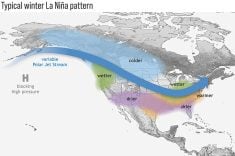Scientists are looking for ways to help cattle producers know when it makes sense to use chemicals to control lice.
Doug Colwell, a parasite specialist with Agriculture Canada’s research centre in Lethbridge, Alta., said although millions of dollars are spent each year on chemicals to control lice, research hasn’t answered the question of how many lice are too many.
Scientists have taken a first step by developing a procedure to determine whether an animal has lice and to evaluate the severity of the infestation, Colwell said.
Read Also

Canadian Food Inspection Agency extends chronic wasting disease control program consultation deadline
Date extended for consultation period of changes to CWD program
“Feedlot personnel should take a good light and a comb and part the animal’s hair, looking for lice on the skin,” he said.
“The places to look are the brisket, around the eyes, on the muzzle and along the back.”
Researchers have developed a basic index to evaluate lice infestations in cattle.
Producers should examine five areas, each six to nine centimetres long, to determine a total lice count.
A total of 10 or fewer lice is considered a minimal infestation, 10 to 50 lice is moderate and anything over 50 is a heavy infestation.
But the index is limited because there are no guidelines correlating lice numbers to treatment requirements.
If chemical treatment is necessary, Colwell recommends a product with guaranteed persistence.
“When you apply a parasite control product in the fall, it will kill all the adults, but it doesn’t kill the eggs on the hair,” he said.
“Seven to 14 days after they were laid, the eggs will hatch and if the product doesn’t have the persistence to kill these new lice, the problem will restart.”
Although there is no perfect safeguard against lice infestation, Colwell said basic management practices can ensure cattle are in optimum condition to fight off the pests.
Nutrition is important to ensure animals have a good immune response.
Animals should be kept clean, well-bedded and dry.
Good animal husbandry, including keeping stress levels low, can minimize damage or help prevent lice infestations.
Some animals become infested with lice but get it under control and never develop a problem again.
Others seem to be resistant and never have problems with lice.
Still others, which are continually susceptible, are referred to as chronic animals and should be culled, said Colwell.
The ultimate goal for parasitologists is to develop a cattle pest index, based on the same techniques used by plant breeders who have developed a crop pest index.
Creating this index would involve intensive studies on various pests to determine economic injury levels for cattle infested by each pest.
Colwell said this tool would help producers control lice in their herds.
“Until we are able to look at all the parameters involved in developing the cattle pest index, producers can go back to the basics to keep lice infestations in check,” he said.














